NCERT Solutions Class 8 Mathematics
Chapter – 6 (Squares and Square)
The NCERT Solutions in English Language for Class 8 Mathematics Chapter – 6 Squares and Square Exercise 6.4 has been provided here to help the students in solving the questions from this exercise.
Chapter 6: Squares and Square Roots
- NCERT Solution Class 8 Maths Ex – 6.1
- NCERT Solution Class 8 Maths Ex – 6.2
- NCERT Solution Class 8 Maths Ex – 6.3
Exercise – 6.4
1. Find the square root of each of the following numbers by Division method.
(i) 2304 (ii) 4489 (iii) 3481
(iv) 529 (v) 3249 (vi) 1369
(vii) 5776 (viii) 7921 (ix) 576
(x) 1024 (xi) 3136 (xii) 900
Solution –
(i) 2304
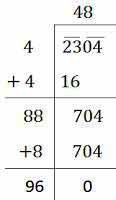
∴ √2304 = 48
(ii) 4489
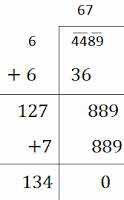
∴ √4489 = 67
(iii) 3481
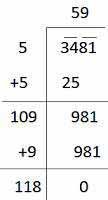
∴ √3481 = 59
(iv) 529

∴ √529 = 23
(v) 3249

∴ √3249 = 57
(vi) 1369

∴ √1369 = 37
(vii) 5776

∴ √5776 = 76
(viii) 7921
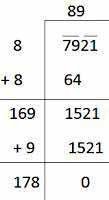
∴ √7921 = 89
(ix) 576

∴ √576 = 24
(x) 1024

∴ √1024 = 32
(xi) 3136

∴ √3136 = 56
(xii) 900
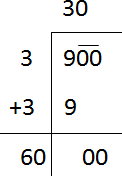
∴ √900 = 30
2. Find the number of digits in the square root of each of the following numbers (without any calculation).
(i) 64
(ii) 144
(iii) 4489
(iv) 27225
(v) 390625
Solution –
(i) 64
Number (n) of digits in 64 = 2 which is even.
∴ Number of digits in the square root of 64.
= 1
(ii) 144
Number (n) of digits in 144 = 3 which is
∴ Number of digits in the square root of 144.
= 2
(iii) 4489
Number (n) of digits in 4489 = 4 which is even.
∴ Number of digits in the square root of 4489.
2
(iv) 27225
Number (n) of digits in 27225 = 5 which is odd.
∴ Number of digits in the square root of 27225.
= 3
(v) 390625
Number (n) of digits in 390625 = 6 which is even.
∴ Number of digits in the square root of 390625.
3
3. Find the square root of the following decimal numbers.
(i) 2.56
(ii) 7.29
(iii) 51.84
(iv) 42.25
(v) 31.36
Solution –
(i) 2.56

∴ √2.56 = 1.6
(ii) 7.29

∴ √7.29 = 2.7
(iii) 51.84
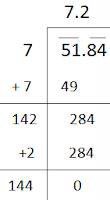
∴ √51.84 = 7.2
(iv) 42.25

∴ √42.25 = 6.5
(v) 31.36

∴ √31.36 = 5.6
4. Find the least number which must be subtracted from each of the following numbers so as to get a perfect square. Also find the square root of the perfect square so obtained.
(i) 402
(ii) 1989
(iii) 3250
(iv) 825
(v) 4000
Solution –
(i) 402
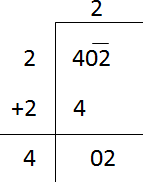
∴ We must subtracted 2 from 402 to get a perfect square.
New number = 402 – 2 = 400
∴ √400 = 20
(ii) 1989

∴ We must subtracted 53 from 1989 to get a perfect square.
New number = 1989 – 53 = 1936
∴ √1936 = 44
(iii) 3250

∴ We must subtracted 1 from 3250 to get a perfect square.
New number = 3250 – 1 = 3249
∴ √3249 = 57
(iv) 825

∴ We must subtracted 41 from 825 to get a perfect square.
New number = 825 – 41 = 784
∴ √784 = 28
(v) 4000

∴ We must subtracted 31 from 4000 to get a perfect square. New number = 4000 – 31 = 3969
∴ √3969 = 63
5. Find the least number which must be added to each of the following numbers so as to get a perfect square. Also find the square root of the perfect square so obtained.
(i) 525
(ii) 1750
(iii) 252
(iv) 1825
(v) 6412
Solution –
(i) 525

This shows that (22)2 < 525
Next perfect square is 232 = 529
Hence, the number to be added is 232 – 525 = 529 – 525 = 4
Therefore, the perfect square so obtained is 525 + 4 = 529
Hence , √529 = 23.
(ii) 1750

This shows that (41)2 < 1750
Next perfect square is 422 = 1764
Hence, the number to be added is 422 – 1750 = 1764 – 1750 = 14
Therefore, the perfect square so obtained is 1750 + 14 = 1764
Hence , √1764 = 42.
(iii) 252

This shows that (15)2 < 252
Next perfect square is 162 = 256
Hence, the number to be added is 162 – 252 = 256 – 252 = 4
Therefore, the perfect square so obtained is 252 + 4 = 256
Hence , √256 = 16.
(iv) 1825

This shows that (42)2 < 1825
Next perfect square is 432 = 1849
Hence, the number to be added is 432 – 1825 = 1849 – 1825 = 24
Therefore, the perfect square so obtained is 1825 + 24 = 1849
Hence , √1849 = 43.
(v) 6412
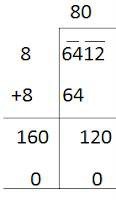
This shows that (80)2 < 6412
Next perfect square is 812 = 6561
Hence, the number to be added is 812 – 6412 = 6561 – 6412 = 149
Therefore, the perfect square so obtained is 6412 + 149 = 6561
Hence , √6561 = 81.
6. Find the length of the side of a square whose area is 441 m2.
Solution – Area of the square = 441 m2
∴ Length of the side of the square = √441 m
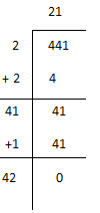
⇒ √441 m = 21.
∴ The length of each side is = 21 m.
7. In a right triangle ABC, ∠B = 90°.
a. If AB = 6 cm, BC = 8 cm, find AC
b. If AC = 13 cm, BC = 5 cm, find AB
Solution –
a. If AB = 6 cm, BC = 8 cm, find AC
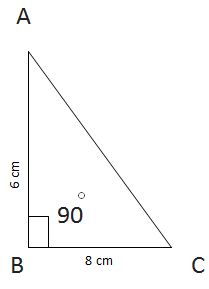
Given, AB = 6 cm, BC = 8 cm
Let AC be x cm.
∴ AC2 = AB2 + BC2
AC =
=
=
=
= 10
Hence, AC = 10 cm.
b. If AC = 13 cm, BC = 5 cm, find AB
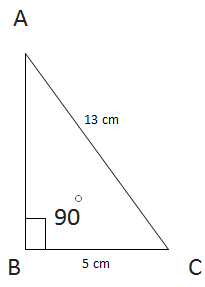
Given, AC = 13 cm, BC = 5 cm
Let AB be x cm.
∴ AC2 = AB2 + BC2
⇒ AC2 – BC2 = AB2
AB =
=
=
=
= 12
Hence, AB = 12 cm
8. A gardener has 1000 plants. He wants to plant these in such a way that the number of rows and the number of columns remain same. Find the minimum number of plants he needs more for this.
Solution – Let the number of rows and column be, x.
∴ Total number of row and column= x × x = x2
x2 = 1000
⇒ x = √1000
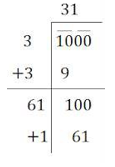
This show that (31)2 < 1000
Next perfect square is 322 = 1024
Hence, the minimum number of plants be need more for this = 1024 – 1000 = 24
9. There are 500 children in a school. For a P.T. drill they have to stand in such a manner that the number of rows is equal to number of columns. How many children would be left out in this arrangement.
Solution – Let the number of rows and column be, x.
∴ Total number of row and column= x × x = x2
x2 = 500
x = √500
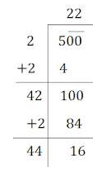
Hence, 16 children would be left out in the arrangement

Leave a Reply